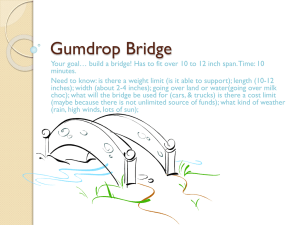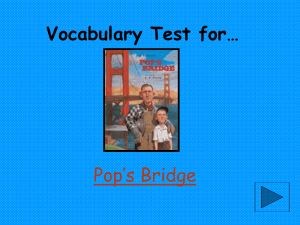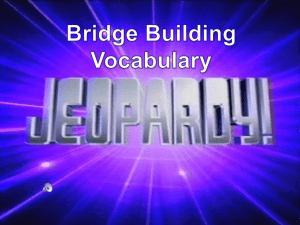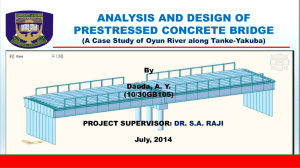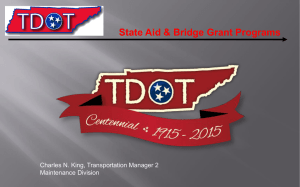BRIDGE DESIGN BY SAIF HAROON Post
advertisement
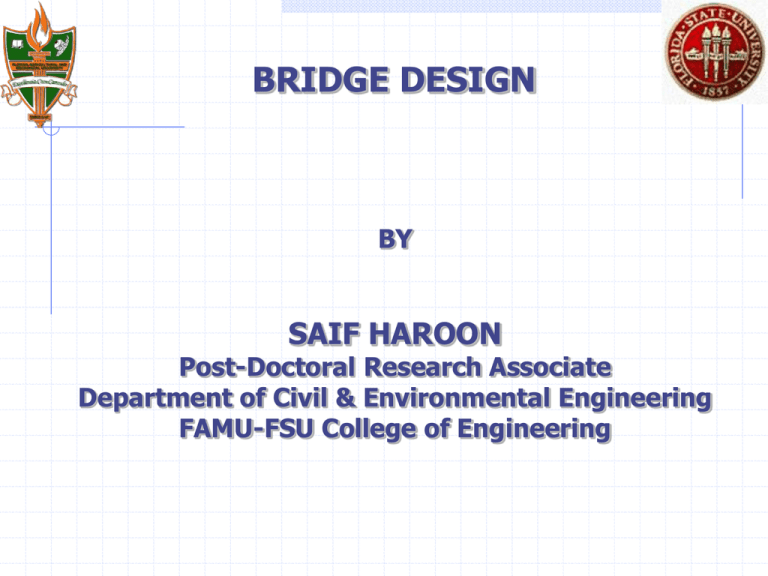
BRIDGE DESIGN BY SAIF HAROON Post-Doctoral Research Associate Department of Civil & Environmental Engineering FAMU-FSU College of Engineering FUNCTION OF A BRIDGE To connect two communities which are separated by streams, valley, railroads, etc. Bosporus Straits Bridge at Istanbul, Turkey – • Replaces a slow ferry boat trip • Connects two continent • Built in 1973 • Total length is 5000 ft COMPONENTS OF A BRIDGE • Deck or Slab: supported roadway on abridge • Beam or Girder: A rigid, usually horizontal, structural element • Abutment: The outermost end supports on a bridge, which carry the load from the deck • Pier: A vertical supporting structure, such as a pillar • Foundation COMPONENTS OF A BRIDGE Deck Girder Abutment Pier TYPES OF BRIDGES •Beam or Girder Bridge •Truss Bridge •Rigid Frame Bridge •Arch Bridge •Cable Stayed Bridge •Suspension Bridge GIRDER BRIDGE • Typical span length 30 to 650 ft • World’s longest: Ponte Costa e Silva, Brazil with a center span of 1000 ft Chesapeake Bay Bridge, Virginia TRUSS BRIDGE • Typical span length 150 to 1500 ft • World’s longest: Pont de Quebec, Canada with a center span of 1800 ft Firth of Forth Bridge, Scotland RIGID FRAME BRIDGE •Girders and piers act together •Cross-sections are usually I-shaped or box-shaped. •Design calculations for rigid frame bridges are more difficult than those of simple girder bridges. ARCH BRIDGE • After girders, arches are the second oldest bridge type. • Arches are good choices for crossing valleys and rivers • Arches can be one of the more beautiful bridge types. Larimer Avenue Bridge, Pittsburgh • Typical span length 130 ft – 500 ft. • World’s longest: New River Gorge Bridge, U.S.A. with a center span of 1700 ft. CABLE STAYED BRIDGE • Continuous girder with one or more towers erected above in the middle of the span. • From these towers cables stretch down diagonally and support the girder. • Typical span length 350 to 1600 ft. • World’s largest bridge: Tatara Bridge, Japan center span: 2900 ft. Normandie Bridge SUSPENSION BRIDGE • Continuous girder with one or more towers erected above in the middle of the span. • At both ends of the bridge, large anchors or counter weights are placed to hold the ends of the cables. • Typical span length 250 to 3000 ft. Golden Gate Bridge, California Factors Describe a Bridge Four main factors are used in describing a bridge: • Span (simple, continuous, cantilever) • Material (stone, concrete, metal, etc.) • Placement of the travel surface in relation to the structure (deck, through) • Form (beam, arch, truss, etc.). Basic Span Types Simple Span Continuous Span Cantilever Span LOADS ON BRIDGES • Permanent Loads: remain on the bridge for an extended period of time (self weight of the bridge) • Transient Loads: loads which are not permanent - gravity loads due to vehicular, railway and pedestrian traffic - lateral loads due to water and wind, ice floes, ship collision, earthquake, etc. VEHICULAR DESIGN LOADS (HL 93) • AASHTO – American Association of State Highway and Transportation Officials This model consists of: • Design Truck • Design Tandem • Design Lane DESIGN TRUCK 145 kN 145 kN 35 kN 4.3 to 9.0 m 4.3 m 9.3 N/m DESIGN TRUCK DESIGN TANDEM 110 kN 110 kN 1.2 m 9.3 N/m DESIGN TANDEM DESIGN PRINCIPLES Resistance ≥ effect of the applied loads Allowable Stress Design (ASD): Strength of the Member ≥ Factor of Safety x Applied Load Load and Resistance Factor Design (LRFD): η ∑γiQi ≤ φi Rn Where, Qi = Effect of loads Rn = Nominal resistance γi = Statistically based resistance factor applied to the force effects φi = Statistically based resistance factor applied to the nominal resistance η = Load modification factor MATERIALS FOR BRIDGES • Concrete • Steel • Wood CONCRETE BRIDGES • Raw materials of concrete: cement, fine aggregate coarse aggregate, water • Easily available • can be designed to satisfy almost any geometric alignment, straight to curved • can be cast-in-place or precast • Compressive strength of concrete range from 5000 psi to 8500 psi • Reinforced concrete and prestressed concrete STEEL BRIDGES • Minimum construction depth • Rapid construction • Steel can be formed into any shape or form • Predictable life • Ease of repair and demolition WOOD BRIDGES • Convenient shipping to the job site • Relatively light, lowering transportation and initial construction cost • Light, can be handled with smaller construction equipment • Approx. 12% of the bridges in US are wood bridges • Commonly used for 20-80 ft span Wood Bridge on Concrete Abutments Three Span Wood Bridge GIRDER CROSS-SECTIONS COMMONLY USED IN BRIDGES COLLAPSE OF BRIDGES • Poor design • Inadequate stability of the foundation • Fatigue cracking • Wind forces • Scour of footing •Earthquake Before Collapse After Collapse AKASHI KAIKYO BRIDGE, JAPAN Completion Date: 1998 Cost: $4.3 billion Length: 12,828 feet Type: Suspension Materials: Steel Span: 6,527 feet SUNSHINE SKYWAY BRIDGE, USA Completion Date: 1987 Cost: $244 Million Length: 29,040 feet Type: Cable Stayed Materials: Steel, Concrete Span: 1200 feet NEW RIVER GORGE BRIDGE, USA Completion Date: 1978 Cost: $37 Million Length: 4,224 feet Type: Arch Materials: Steel Span: 1700 feet THANK YOU



